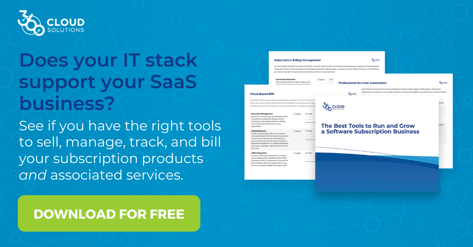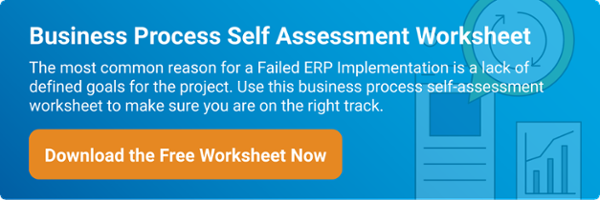While subscription-based SaaS products have become more mainstream for consumers, the behind-the-scenes business processes of the companies that develop them remain unique and a bit complex. Think about it: what once was billed on a one-time basis is now billed on a regular, recurring basis—whether that be monthly, quarterly, annually, or anywhere in between.
Subscription models typically make the software more attainable for customers through lower costs and OpEx classification but can quickly create an administrative nightmare behind the scenes. Once you start growing, the difficulties only multiply.
As we speed toward subscription billing ubiquity, something has to give. There has to be a simpler, compliant solution that does not involve an application that sits outside of an ERP system. After all, billing is the central hub where the invoices, compensation, and revenue recognition information lives. That’s why subscription billing software for SaaS companies needs to work seamlessly with the rest of your operations.
Subscription billing models (sometimes called recurring billing) are the cornerstone of any software as a service (SaaS) revenue stream. Yet, few companies are getting the most out of their subscription program.
If you’re looking to glean all of the benefits that SaaS offers businesses—seamless administration, cross-compatibility, universal accessibility—incorporating recurring revenue and subscription options to your billing model will create a steady, predictable revenue stream each month.
What is Subscription Billing?
Subscription billing charges customers a predetermined rate at a regular, predetermined interval, i.e., monthly, quarterly, or yearly. Membership fees and monthly subscriptions are ideal for giving clients what they need at a lower rate, and they spread out monthly payments and charge smaller fees per billing period.
For business customers, subscription-based purchases are typically classified as operating expenses which boils down to fewer headaches and more cash flow. Many software services companies charge hefty up-front fees, which turn some businesses away.
Read More: Recurring Billing Software: Benefits, Best Practices, and More
Why Do SaaS Companies Need Subscription Billing Software?
Very few companies start with the technology they need to grow. This statement is especially true in the software industry as there is little to no overhead required—just a computer, developers, and a dream to conquer the world.
When it comes time to “go to market”, many early-stage development companies invest in introductory bookkeeping software instead of a comprehensive, enterprise-level business management tool. Such a decision is understandable, as early-stage SaaS companies often don’t have the bandwidth or the operating capacity to contend with the complexities of an enterprise management system.
But as a SaaS company grows, a new set of challenges can quickly arise—namely, financial management, recurring billing, and revenue recognition. And as success continues, so do the hurdles: international expansion, payroll, sales, planning & budgeting, and project management.
It boils down to this: no matter how innovative your software offerings are, you need to have the back-office infrastructure to support your growth, make your customers happy, and keep the cash flowing. The minute you stop providing value anywhere along this value chain, your customers will stop providing revenue.
Before we dig more into subscription billing and how it fits into the ERP equation, let’s first take a look at some of the most common problems SaaS companies face and how they can stop growth in their tracks.
5 Common Issues in SaaS Companies
 |
1: Disjointed ProcessesYou’re frustrated by:
|
 |
2: Painful ClosingsYou’re frustrated by:
|
 |
3: Slow Order-to-Cash ProcessYou’re frustrated by:
|
 |
4: Rev Rec ProblemsYou’re frustrated by:
|
 |
5: Manual Billing & Subscription ManagementYou’re frustrated by:
|
Why do so many SaaS companies struggle with the same problems? A hodgepodge of disparate business management systems (CRM, professional services management, accounting, billing) that don’t talk to each other or share information in real-time.
Best Practices for SaaS Companies Using Subscription Billing Software
Even though Amazon is not in the software industry, they are a great example of subscription management. Amazon has a recurring billing stream, but you might not know it because their program goes under the name “Subscribe and Save.” Customers subscribe by the millions to Amazon’s program, enabling more predictable income streams.
The takeaway from Amazon’s success is that subscription programs can be tailored to nearly any product or service, but your business must always provide value. The client needs to have a consistent, high-quality experience every time they use your product or service, so they continue their subscription.
Here are seven subscription billing best practices to keep in mind.
1. Keep Subscriptions Simple
Since clients usually prefer prepaid recurring billing over budget-weakening, lump-sum payments, you should focus on streamlining the number of options you give your customers. The simpler the program is, the easier it is to digest as a consumer.
Keep things simple yet offer two to four prepaid recurring billing plans, so you don’t overwhelm your audience. From a customer’s perspective, the price of the product and its benefits are the two most important aspects of the subscription. Get that balance right, and you’ve just created trust with customers and enhanced your conversions.
Customers ultimately want to feel like they can conveniently get what they want without too much fuss. Accordingly, you might want to offer free trials to help customers get acquainted with your services.
2. Balance Risk, Trust, and Fairness
It is good practice to give customers the benefit of the doubt by not requiring credit card details during the free-trial period. This creates much more trust between you and your clients and is less inherently risky from the customer’s perspective should they decide that your service isn’t the right fit.
Fairness also means making sure that it’s crystal-clear to clients that they’re enrolled in the subscription and having defined internal billing processes. Part of being fair, eliminating risk, and improving trust is to have a well-managed billing process.
3. Show Visibility
Whether the recurring bill is for a subscription service (such as a software subscription) or products (such as Barkbox), one of the most important subscription billing best practices is to ensure your business and terms are visible. Have a packet of collateral ready for potential clients that includes pricing tables, terms, cancellation policy, additional charges, and more. This enables customers to make informed decisions about your products, services and ensures there are no surprises for either party.
4. Make Cancellations & Changes Simple
When the time comes for a customer to cancel or change their subscription, it should be a simple process. Having a complicated cancellation process will lead to complaints that harm customer loyalty and the reputation of your brand. To avoid issues like these, present clear terms of service and customer education right from the get-go and have these documents available in a client portal or other communication platform.
5. Keep in Touch with Customers
Once a subscription or contract has been signed it is important to keep the communication going with customers. For example, send newsletters with product or service updates, or notify customers of changes and give clear explanations as to how they will be affected. Ultimately, the key to growing your subscription business is to establish long-term customer relationships. Continue interactions through the billing period, issue surveys, and encourage customers to contact you with questions and concerns. Identifying problems ahead of time will lead to greater customer satisfaction and fewer cancellations.
6. Clear and On-brand Communications
Subscriptions come in many different forms. Communicating with clearly labeled receipts and invoices allows customers to know exactly what they are paying for and more easily understand the value you are providing them. Whether it is an upgrade, a renewal, or a discount, it is key to keep customers in the know. Keep charges consistent and brand them effectively so they are noticed quicker on bank and account statements. This lowers the chances of charge disputes and increases customer service.
7. Utilize Recurring Billing Tools
Choosing to modernize your business with a recurring billing model is a big decision. One thing to keep in mind is that creating your own billing solution will most likely not be scalable. Using spreadsheets and other manual processes can lead to significant errors. Having to clean up manual messes leaves less time for creating innovative products, services, and focusing on how to grow your business. Luckily there are software solutions that automate your processes, leaving more time to focus on what your business does best.
I have a mix of license and service offerings. What if I need more than a subscription billing software?
For SaaS companies, that’s often the case. Here’s why:
- Being able to start billing and recognizing revenue for the subscription usually also requires that the license be activated and/or the services be completed as well, if applicable.
- Including all bundled elements (software subscription, professional services, etc.) in the same order is critical for revenue recognition. Remember, per ASC606; they must be all together for “Fair Value Recognition” to keep them in compliance.
- Being able to manage professional services and related billings along with SaaS subscriptions all in one system while, at the same time, keeping it simple enough for your teams and providing a great user experience. Scaling your business can be challenging if internal pains from consolidating, co-terming, and prorating charges become transparent to your customers.
And that means…?
You need to have the right mix of technology and processes in place to sell, manage, track, and bill both the license(s) and associated subscription services for the lifetime of the relationship. For SaaS companies, that stack typically looks something like:
- Cloud-based ERP is a scalable financial management solution that automates critical processes from billing and revenue recognition to payables and payroll and provides complete and real-time visibility into financial performance.
- Professional Services Automation – A PSA system should streamline bid-to-bill processes associated with your services division and include project and resource management, project financials, and invoicing capabilities.
- Subscription Billing Platform – Automate recurring billing with easy renewals, subscription changes, rev rec compliance, device/assets/sites tracking, real-time integration with the financial system.
NetSuite + 360 Subscription Billing
Built with SaaS companies in mind, NetSuite provides built-in functionality to meet the complex requirements of software-as-a-service companies. From accounting to project management, budgeting to payroll—NetSuite is the world’s #1 cloud ERP system with native functionality to meet these needs.
When integrated with 360 Subscription Billing, it’s easier than ever for growing software subscription companies to expedite financial processes, ensure compliance, manage recurring revenue, deliver quality services, and more—all in one system.
It’s time to leave the manual labor and disjointed, siloed business processes where they belong—in the past. Get connected with one of our experts to discover the potential.
In conclusion
What is central to successfully implementing any business-changing solution is the approach. An agile, flexible approach increases the frequency of interaction and deliverables while increasing the likelihood of success.
With the recent boom of companies offering subscription-based products and services, there is no shortage of recurring billing software platforms to choose from. Like most other software purchases, which is right for you is primarily based on your business’s specific needs.
A close relationship with the business team builds the foundation of a long and value-driven relationship. 360 Cloud Solutions’ customers have employed 360 Contract Billing to propel their subscription business, gain visibility into customer billing activity, reduce costs, and eliminate manual errors—making their business stronger.
Curious to learn more? Build a custom 360 Subscription Billing demo today!





